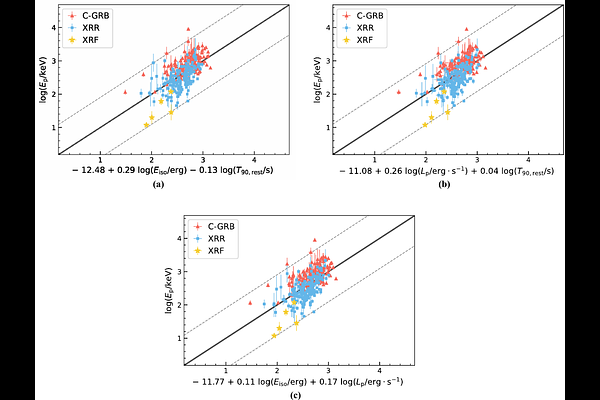Softness Ratio of SWIFT Gamma-ray Bursts and Relevant Correlations

Softness Ratio of SWIFT Gamma-ray Bursts and Relevant Correlations
Fan Xu, Yong-Feng Huang, Liang Li, Jin-Jun Geng, Xue-Feng Wu, Song-Bo Zhang, Chen Deng, Chen-Ran Hu, Xiao-Fei Dong, Hao-Xuan Gao
AbstractThe properties of X-ray flashes (XRFs) and X-ray rich gamma-ray bursts (XRRs) as compared with classical gamma-ray bursts (C-GRBs) have been widely discussed during the \emph{Swift} era. It has been proposed that XRFs and XRRs are low-energy extensions of the GRB population so that they should follow similar correlations. To further examine this idea, we collect a sample of $303$ GRBs detected by \emph{Swift} over the past two decades, all of which have reliable redshifts and spectral parameters. The bursts are classified into XRFs, XRRs, and C-GRBs based on their softness ratio (SR), which is calculated by dividing the $25-50$ keV fluence with the $50-100$ keV fluence. A strong correlation is found among the isotropic energy $E_{\mathrm{iso}}$, peak luminosity $L_{\mathrm{p}}$, and rest frame burst duration $T_{90, \mathrm{rest}}$, i.e., $E_{\mathrm{iso}} \propto L_{\mathrm{p}}^{0.88\pm0.02} T_{90, \mathrm{rest}}^{0.58\pm0.02}$. Additionally, two tight three-parameter correlations involving SR and the rest-frame peak energy $E_{\mathrm{p}}$ are also derived, i.e. $E_{\mathrm{p}} \propto E_{\mathrm{iso}}^{0.20\pm0.02} \mathrm{SR}^{-2.27\pm0.15}$ and $E_{\mathrm{p}} \propto L_{\mathrm{p}}^{0.17\pm0.02} \mathrm{SR}^{-2.33\pm0.14}$. It is interesting to note that XRFs, XRRs, and C-GRBs all follow the above correlations. The implications of these correlations and their potential application in cosmology are discussed.